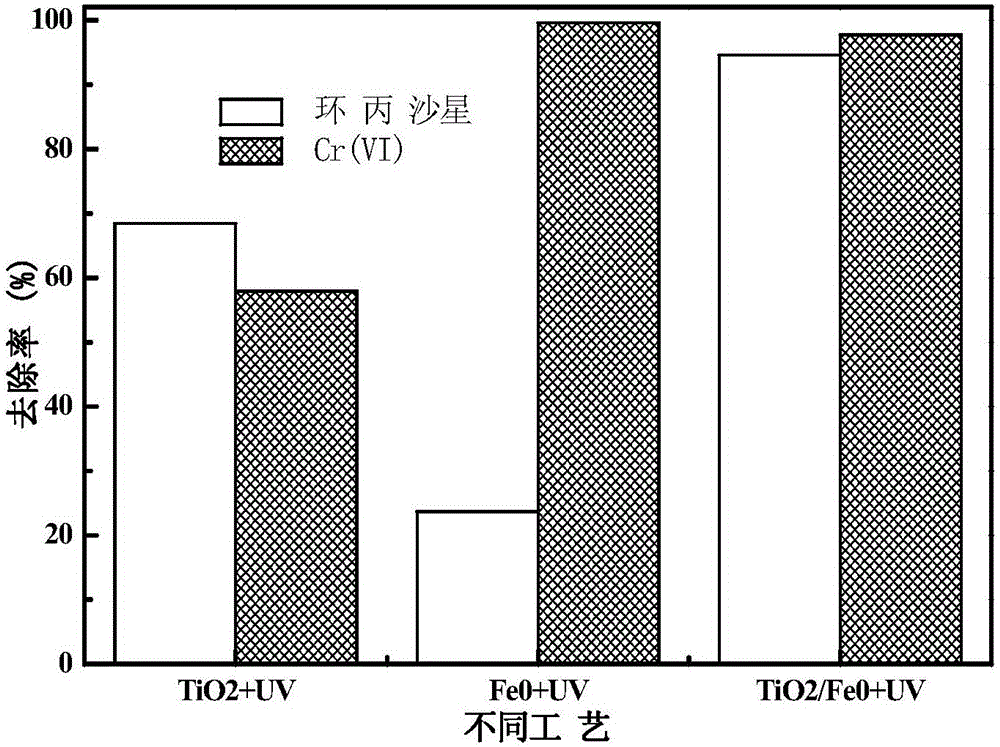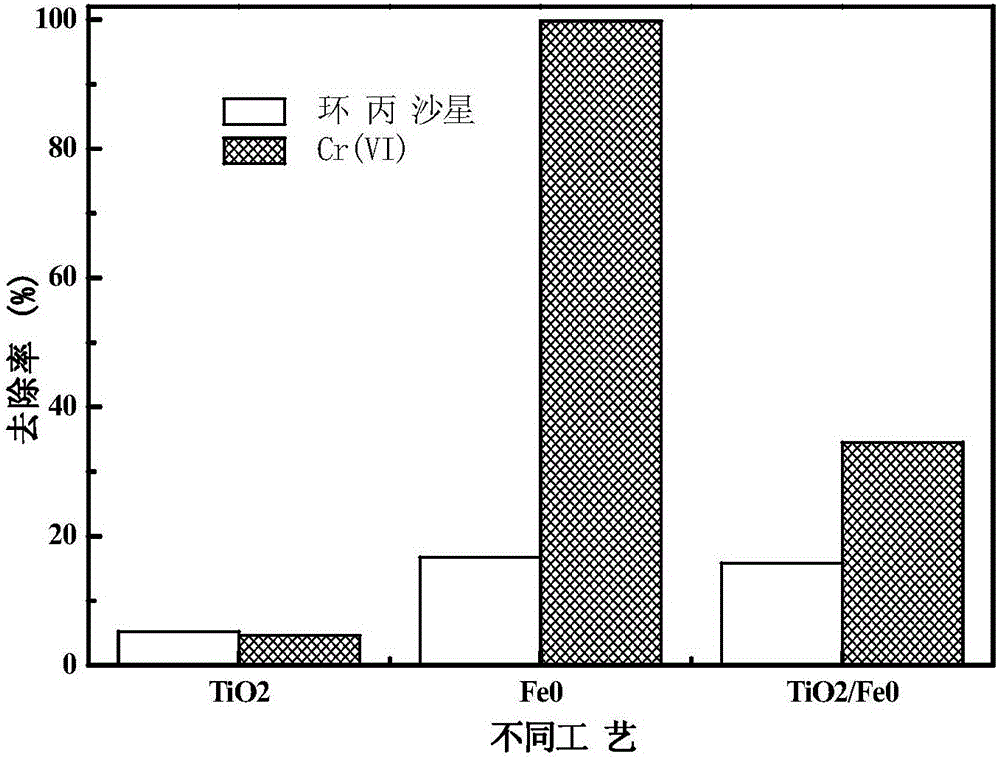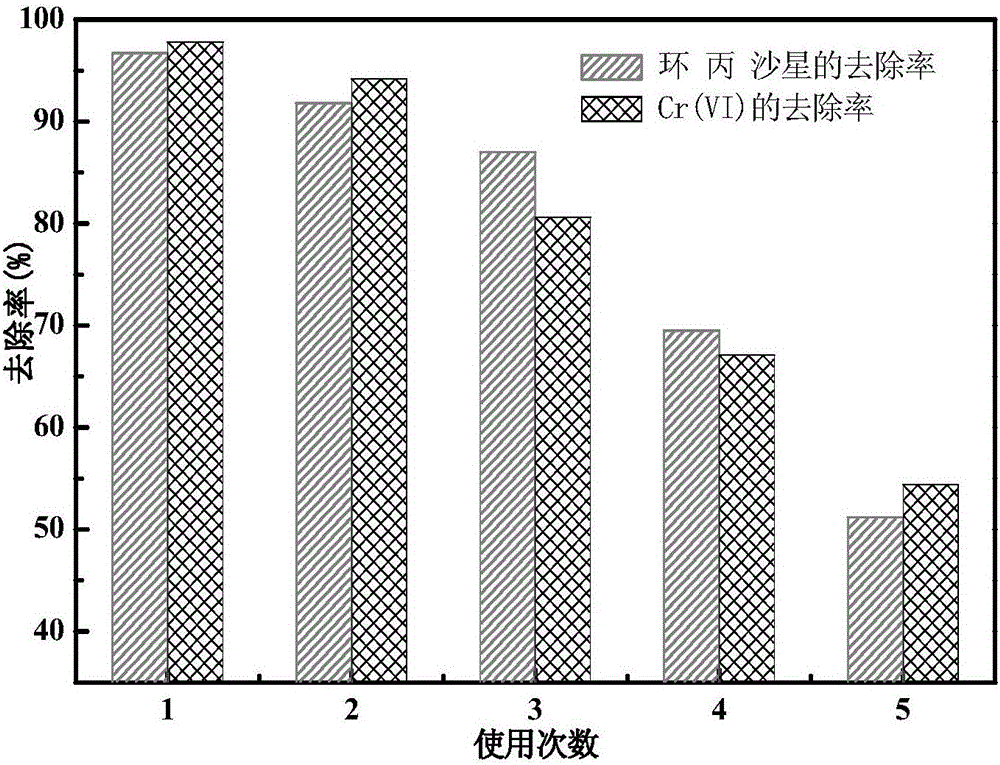Method for removing heavy metal-organic combined pollutants in water by utilizing TiO2/FeO composite photocatalyst
A catalyst and composite light technology, applied in water pollutants, physical/chemical process catalysts, chemical instruments and methods, etc., can solve the problem of high recombination rate, and achieve the effect of improving reaction activity, reducing agglomeration and simple operation.
- Summary
- Abstract
- Description
- Claims
- Application Information
AI Technical Summary
Problems solved by technology
Method used
Image
Examples
Embodiment 1
[0027] Example 1: TiO 2 / Fe 0 Preparation of Composite Photocatalyst
[0028] In a 100mL three-neck flask, add 25mL of the mixed solution (V 乙醇 :V 水 =4:1), weigh 0.05g FeSO 4 ·7H2 O was added to the mixture and stirred until completely dissolved. Next, weigh 1g TiO 2 Add it to a three-necked flask, and stir for 10 minutes under nitrogen protection to ensure complete and uniform mixing. Subsequently, the excess NaBH was added dropwise to 4 The solution was added to the mixed solution in the three-necked flask, and continued to stir for 20 minutes. After the reaction was completed, the black solid was separated by vacuum filtration, then washed with ethanol, placed in a vacuum drying oven, and dried at 75°C, and then stored in a container filled with A brown bottle of nitrogen, from which TiO 2 / Fe 0 composite photocatalyst. Alone Fe 0 The preparation method, except not adding TiO 2 Besides, other conditions are the same as TiO 2 / Fe 0 The preparation conditions of...
Embodiment 2
[0030] Addition of TiO to water containing Cr(VI) and ciprofloxacin under UV light irradiation 2 / Fe 0 Composite photocatalyst for simultaneous removal of Cr(VI) and ciprofloxacin. The specific steps are: use a 100mL quartz tube as a reaction bottle, treat 50mL of water with a concentration of 20mg / L Cr(VI) and 30mg / L ciprofloxacin, and adjust the pH of the water to 3.0. Add respectively the TiO prepared in embodiment 1 to each reaction bottle 2 / Fe 0 Composite photocatalyst, Fe 0 and TiO 2 , so that the final concentration is 1.00g / L, and the reaction bottle is placed on the photocatalytic reactor, the stirrer speed is 120rpm, the ultraviolet light irradiation reaction time is 60min, the power of the ultraviolet light is 10W, and its main incident The wavelength is 254nm. Specific results such as figure 1 shown.
Embodiment 3
[0035] A 100mL quartz tube was used as a reaction bottle, and 50mL of water containing 20mg / L Cr(VI) and 30mg / L ciprofloxacin were simultaneously removed, and the pH of the water was adjusted to 3.0, 6.0, and 9.0, respectively. Add the TiO prepared in Example 1 to reaction flasks containing water bodies of various pH values respectively 2 / Fe 0 Composite photocatalyst so that its final concentration is 1.00g / L. And the reaction bottle was placed on the photocatalytic reactor, the rotation speed of the stirrer was 120rpm, the reaction time of ultraviolet light irradiation was 60min, the power of the ultraviolet light was 10W, and its main incident wavelength was 254nm. The concentration changes of Cr(VI) and ciprofloxacin in the water before and after the reaction were measured. The results are shown in Table 1. It can be seen from Table 1 that in this catalytic system, the simultaneous removal of Cr(VI) and ciprofloxacin is significantly dependent on pH conditions. In the...
PUM
| Property | Measurement | Unit |
|---|---|---|
| particle diameter | aaaaa | aaaaa |
Abstract
Description
Claims
Application Information
 Login to View More
Login to View More - R&D
- Intellectual Property
- Life Sciences
- Materials
- Tech Scout
- Unparalleled Data Quality
- Higher Quality Content
- 60% Fewer Hallucinations
Browse by: Latest US Patents, China's latest patents, Technical Efficacy Thesaurus, Application Domain, Technology Topic, Popular Technical Reports.
© 2025 PatSnap. All rights reserved.Legal|Privacy policy|Modern Slavery Act Transparency Statement|Sitemap|About US| Contact US: help@patsnap.com



